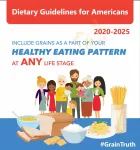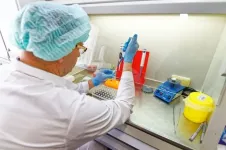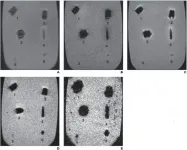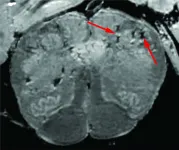(Press-News.org) People have puzzled for years why pathogen Phytophthora infestens causes the devastating late blight disease, source of the Irish Potato famine, on potatoes, but has no effect at all on plants like apple or cucumber. How are apple trees and cucumber plants able to completely shake off this devastating pathogen? Agricultural scientists have wondered for years: if this resistance is so complete and persists over so many generations, is there some way we could transfer it to susceptible plants like wheat and thereby stop disease?
Why is it so important to determine the molecular basis of nonhost resistance?
There are many examples of plants that are susceptible to one pathogen but able to resist another closely related pathogen. By uncovering the mechanism behind resistance, we can obtain a deeper understanding of the plant immune system and can also uncover previously unknown aspects of immune signaling and regulation, which can help scientists improve resistance against a broader spectrum of pathogens.
This question has always been important as pathogens are a consistent threat to agriculture, limiting how much food is produced and where crops can be grown. Scientists continue to learn ways to reduce the impact of disease, through the development of pesticides, implementing new practices in the field, and breeding crops with enhanced resistance.
However, the modern world inadvertently undermines these efforts in a number of ways. Globalization and increased movement have contributed to the spread of pathogens into new environments. A prominent example is the recent emergence of wheat blast disease caused by the fungus Magnaporthe oryzae, which for a long time was unable to colonize wheat.
"The field of nonhost resistance sets out to identify novel ways to engineer resistance to these plant pathogens, guided by approaches that already exist in nature," explained Matthew Moscou, a scientist at The Sainsbury Laboratory in Norwich, United Kingdom. "This question is fundamental to understanding why some plants get infected by a particular pathogen and others don´t, and, vice versa, why a given pathogen can only successfully colonize a limited number of plant species, which collectively form its host range."
What do we know about nonhost resistance?
Scientists have learned that nonhost resistance is a feature controlled by many genes and largely governed by the characteristic attributes of a given plant-pathogen constellation. Pre-existing and induced physical barriers, such as the plant cuticle, and the secretion of antimicrobial molecules are often key factors in nonhost resistance. More recently scientists have recognized the interplay of host NLR-type immune sensors and secreted pathogen effector proteins as another important determinant of nonhost resistance.
What don't we know about nonhost resistance?
"While the contribution of microbial commensals (microbes that naturally inhabit plant organs without causing any harm) to plant immunity has emerged during the past few years, their explicit role in nonhost resistance has not been demonstrated yet", said Ralph Panstruga, a scientist at RWTH Aachen University in Germany. "Our knowledge on nonhost resistance largely relies on findings obtained in a handful of (model) angiosperm plant species that are genetically very tractable. We do not know yet to what extent these insights can be generalized, especially with respect to non-angiosperms."
While there is a lot we don't know about nonhost resistance, recent advances in technology, such as DNA sequencing methods, will make it easier for scientists to learn more. As for understanding the contribution of microbial commensals, scientists have recently been able to explore this aspect through reconstitution experiments with synthetic microbial communities in combination with germ-free plant systems. These tools were only recently established for some model plant species and are not yet available for many agriculturally important crops.
What can come from answering this question?
Learning more about nonhost resistance will help scientists better appreciate that susceptibility and resistance are the extreme outcomes of interactions between plants and pathogens, with all kinds of intermediate forms possible. Scientists may also discover undiscovered of plant pathogens on some species, which will enhance disease control strategies. Answering this question will also help scientists further comprehend whether microbial commensals contribute to resistance, which could form the basis for future plant protection measures. Finally, these insights will complete our picture of the plant immune system.
For the full review, read "What is the Molecular Basis of Nonhost Resistance?" published in the November issue of the MPMI journal. This article is the first in a series of ten reviews exploring the top 10 unanswered questions in molecular plant-microbe interactions, which came out of a crowdsourcing initiative spearheaded by the MPMI journal's editorial board at the 2019 International Congress on Molecular Plant-Microbe Interactions in Glasgow, Scotland.
When meeting attendees Panstruga and Moscou heard about the quest to identify the top 10 unanswered questions in MPMI, they were immediately fascinated. When they saw the final list, they were drawn to the question about nonhost resistance, a plant defense that provides immunity to all members of a plant species against a microorganism that is harmful to other plant species.
"Since we both have published expertise in the area of nonhost resistance, it was somewhat self-evident that we could contribute with a review article to this relevant question," said Panstruga. "We felt for quite some time that some concepts and terms in the field are ambiguous and possibly misleading, and that it would be just the right time to sum up the present knowledge, but also to clarify a few aspects and to raise a few fresh ideas."
INFORMATION:
See the list of the top 10 unanswered questions here.
Toronto - With the arrival of effective vaccines for the COVID-19 virus, the end of the pandemic is on the horizon but in the short term the virus continues to spread.
A timely new study published today by PLOS ONE examines the effectiveness of COVID-19 control policies in 40 jurisdictions including countries and U.S. states.
Among the conclusions is that significant social costs must be incurred to reduce the growth of the virus below zero. In most jurisdictions examined, policies with a lesser social impact including cancellation of public events, restrictions of gatherings ...
The Grain Chain, a farm to fork coalition of stakeholders in the grain industry sector and chaired by the American Bakers Association (ABA), celebrates the recommendation published today in the 2020-2025 Dietary Guidelines for Americans (DGAs) to "consume half of your grains from whole grain sources" and the remainder from enriched grains. A foundational piece of the DGAs, the guidelines recognize whole grains are "one of the three food groups that are fundamental constituents of a healthy dietary pattern."
The United States Department of Agriculture (USDA) and Health and Human Services (HHS) oversee and publish the Dietary Guidelines, ...
BIRMINGHAM, Ala. - COVID-19, which has killed 1.7 million people worldwide, does not follow a uniform path.
Many infected patients remain asymptomatic or have mild symptoms. Others, especially those with comorbidities, can develop severe clinical disease with atypical pneumonia and multiple system organ failure.
Since the first cases were reported in December 2019, the SARS-CoV-2 virus that causes COVID-19 has surged into a pandemic, with cases and deaths still mounting. Ongoing observational clinical research has become a priority to better understand how this previously unknown virus acts, and findings from this research can better inform treatment and vaccine design.
University ...
Carrageenans, biologically active polysaccharides isolated from red algae and widely used in the food industry as stabilizers, thickeners, or jelly agents have an express effect on the immune systems of mice, a study reports. The research was carried out by scientists from the School of Biomedicine of Far Eastern Federal University (FEFU), Far Eastern Branch of the Russian Academy of Sciences, and Vilnius University. A related article appears in the Journal of Biomedical Materials Research.
"The fact that carrageenan demonstrates immunosuppressive properties in a particular case does not make it generally dangerous or toxic though", says Aleksandra ...
Leesburg, VA, December 29, 2020--According to an article in ARRS' American Journal of Roentgenology (AJR), because patients with ballistic embedded fragments are frequently denied MRI (due to indeterminate bullet composition sans shell casings), radiography and CT can be used to identify nonferromagnetic projectiles that are safe for MRI.
"Commercially available handgun and shotgun ammunition representing projectiles commonly encountered in a clinical setting was fired into ballistic gelatin as a surrogate for human tissue," explained first author Arthur J. Fountain from the department of radiology and imaging sciences at Emory ...
While the world has its eyes on vaccines to stop the spread of coronavirus, therapeutics are still necessary to treat hospitalized patients. One of these treatments, remdesivir, is the first and only antiviral agent of its kind that the U.S. Food and Drug Administration (FDA) has approved so far for COVID-19.
Research at the University of Cincinnati, however, contends that this antiviral drug is being used too indiscriminately when treating patients hospitalized with the virus. The study is published in the journal Fundamental & Clinical Pharmacology.
The FDA approved remdesivir, marketed as Veklury, for emergency use authorization in May 2020 to treat COVID-19 and granted full approval ...
Mobile apps have revolutionised the way people meet in Switzerland and elsewhere in recent years. Unlike traditional dating sites, these apps do not feature detailed user profiles but are largely based on rating photos using a swipe review system. As dating apps escalated in popularity, so has criticism about them encouraging casual dating only, threatening the existence of long-term commitment, and possibly damaging the quality of intimacy. There is no scientific evidence, however, to validate these claims. A study by the University of Geneva (UNIGE), Switzerland, provides a wealth of information about couples who met through dating apps, drawing on data from a 2018 Swiss survey. The results, ...
Very low birthweight infants often need blood transfusions to survive. A National Institutes of Health-funded study suggests that providing a higher threshold of red cells within accepted limits offers no advantage in survival or reduction in neurological impairment over a lower threshold. The research was conducted by Haresh Kirpalani, B.M., of the University of Pennsylvania, Philadelphia, and colleagues and was funded by the NIH's Eunice Kennedy Shriver National Institute of Child Health and Human Development (NICHD), National Heart, Lung, and Blood Institute, and National Center for Advancing Translational Sciences. The study appears in The ...
Women awaiting liver transplants in the United States are known to be about one-third more likely than men to become too ill to undergo surgery or die before receiving a liver. Now a study headed by UC San Francisco and Columbia University highlights the role that frailty plays in this gender gap.
The study followed 1,405 patients with cirrhosis, of whom 41 percent were women, awaiting liver transplantation at nine transplant centers in the United States. The men, whose ages ranged from 49 to 63, were more likely to have chronic hepatitis C and alcoholic liver disease (27 percent versus 22, and 33 percent versus 19 percent). The women, whose ages ranged ...
In an in-depth study of how COVID-19 affects a patient's brain, National Institutes of Health researchers consistently spotted hallmarks of damage caused by thinning and leaky brain blood vessels in tissue samples from patients who died shortly after contracting the disease. In addition, they saw no signs of SARS-CoV-2 in the tissue samples, suggesting the damage was not caused by a direct viral attack on the brain. The results were published as a correspondence in the New England Journal of Medicine.
"We found that the brains of patients who contract infection from SARS-CoV-2 may be susceptible to microvascular blood vessel damage. Our results ...







